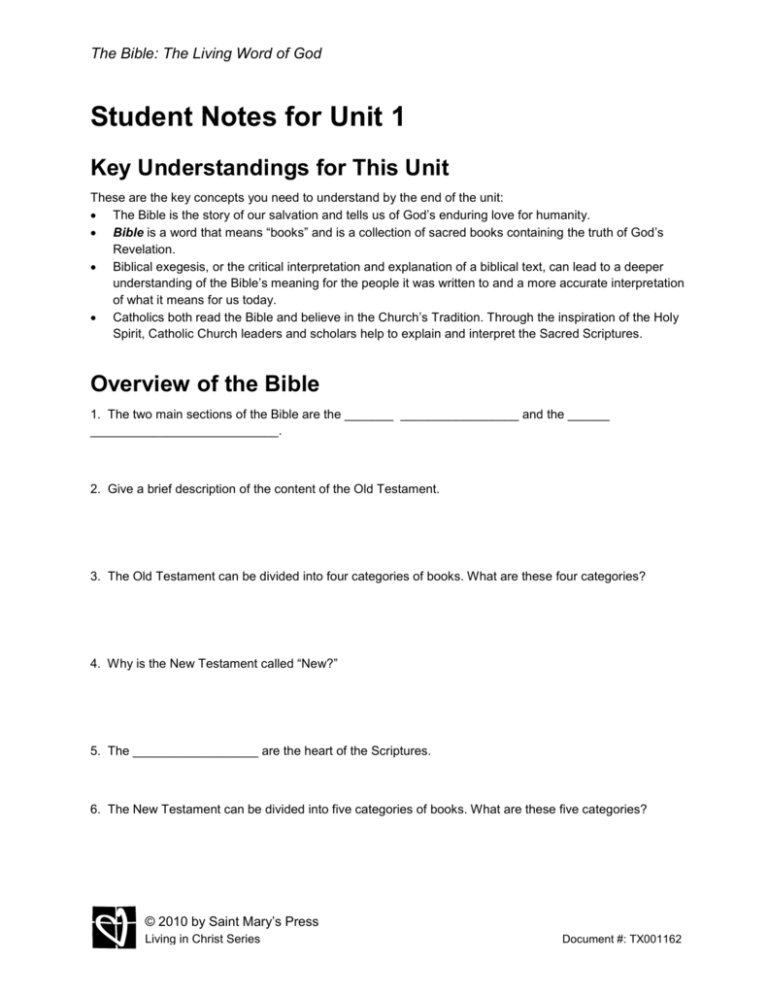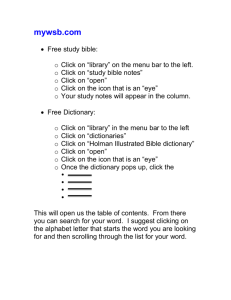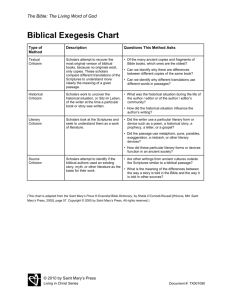Word - Saint Mary`s Press
advertisement

The Bible: The Living Word of God Student Notes for Unit 1 Key Understandings for This Unit These are the key concepts you need to understand by the end of the unit: The Bible is the story of our salvation and tells us of God’s enduring love for humanity. Bible is a word that means “books” and is a collection of sacred books containing the truth of God’s Revelation. Biblical exegesis, or the critical interpretation and explanation of a biblical text, can lead to a deeper understanding of the Bible’s meaning for the people it was written to and a more accurate interpretation of what it means for us today. Catholics both read the Bible and believe in the Church’s Tradition. Through the inspiration of the Holy Spirit, Catholic Church leaders and scholars help to explain and interpret the Sacred Scriptures. Overview of the Bible 1. The two main sections of the Bible are the _______ _________________ and the ______ ___________________________. 2. Give a brief description of the content of the Old Testament. 3. The Old Testament can be divided into four categories of books. What are these four categories? 4. Why is the New Testament called “New?” 5. The __________________ are the heart of the Scriptures. 6. The New Testament can be divided into five categories of books. What are these five categories? © 2010 by Saint Mary’s Press Living in Christ Series Document #: TX001162 Student Notes for Unit 1 Page | 2 How the Bible Came to Be The Bible went through several steps of storytelling, writing, and approval in its formation. This process lasted well over a thousand years. Depending on what steps are included, people count three to five steps in the formation of the Bible. You will learn five steps in class. 1. Fill in the missing steps in the formation of the Bible. A. People experienced God over a long period of time. B. People shared the stories of their experiences of God ____________. C. The leaders of the Church determined the official collection of inspired books that is the Bible. This official collection is called the ____________. D. People speaking different languages ______________________ the Bible into their own languages from the Bible’s original languages which are ______________, __________________, and ________________. 2. _____________ _______________ is the handing on of the message of God’s saving plan through words and deeds. 3. Why were the early Christians especially concerned about protecting and safeguarding the message of Jesus Christ by writing it down? 4. What are the four standards used by the bishops of the Church to discern which books to include in the canon of the Bible? 5. What are four commonly used Catholic Bible English translations? © 2010 by Saint Mary’s Press Living in Christ Series Document #: TX001162 Student Notes for Unit 1 Page | 3 Interpreting the Scriptures 1. Describe what is meant by a fundamentalist approach to biblical interpretation. 2. Describe what is meant by a contextualist approach to biblical interpretation. 3. How has biblical archaeology helped us to better understand the Scriptures? 4. To help us in interpreting the Bible, Saint Thomas Aquinas described two main senses of Scripture, the literal sense and the spiritual sense. He also broke the spiritual sense of Scripture into three categories: allegorical sense, moral sense, and the anagogical sense. Match these senses of Scripture to their definitions. Literal sense How the people, events, and things in the Bible point to the life, death, and Resurrection of Jesus Christ. Allegorical Sense Investigating the eternal significance of the events and teachings in the Bible. Moral Sense The obvious meaning of the text. Anagogical Sense How a passage instructs us to live in right relationship with God, neighbor, self, and the earth. Biblical Exegesis 1. Define biblical exegesis. 2. A biblical scholar “must be attentive to what the human authors truly wanted to affirm and to what God wanted to reveal to us by their words” (Catechism of the Catholic Church, 109). In doing this the scholar must study the _____________ in which the biblical author lived. The scholar must also look at the various ________________ _______________ and ______________ commonly used at the time. 3. Thorough exegesis must be done by keeping in mind the larger truths revealed in the Scriptures and Tradition. How does this affect the interpretation of a particular text or passage of the Bible? © 2010 by Saint Mary’s Press Living in Christ Series Document #: TX001162 Student Notes for Unit 1 Page | 4 4. The unity of the Church’s doctrine, the coherence of God’s revealed truth is called the _______________ ____ ____________. The quotation labeled Catechism of the Catholic Church is from the Catechism of the Catholic Church for use in the United States of America, second edition, number 109. Copyright © 1994 by the United States Catholic Conference, Inc.—Libreria Editrice Vaticana. English translation of the Catechism of the Catholic Church: Modifications from the Editio Typica copyright © 1997 by the United States Catholic Conference, Inc.—Libreria Editrice Vaticana. © 2010 by Saint Mary’s Press Living in Christ Series Document #: TX001162







